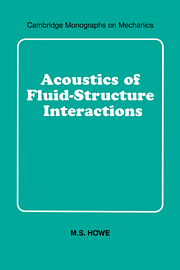3 - Sound generation in a fluid with rigid boundaries
Published online by Cambridge University Press: 22 March 2010
Summary
Influence of Rigid Boundaries on the Generation of Aerodynamic Sound
The Ffowcs Williams–Hawkings equation (2.2.3) enables aerodynamic sound to be represented as the sum of the sound produced by the aerodynamic sources in unbounded flow together with contributions from monopole and dipole sources distributed on boundaries. For turbulent flow near a fixed rigid surface, the direct sound from the quadrupoles Tij is augmented by radiation from surface dipoles whose strength is the force per unit surface area exerted on the fluid. If the surface is in accelerated motion, there are additional dipoles and quadrupoles, and neighboring surfaces in relative motion also experience “potential flow” interactions that generate sound. At low Mach numbers, M, the acoustic efficiency of the surface dipoles exceeds the efficiency of the volume quadrupoles by a large factor ∼O(1/M2) (Sections 1.8 and 2.1). Thus, the presence of solid surfaces within low Mach number turbulence can lead to substantial increases in aerodynamic sound levels. Many of these interactions are amenable to precise analytical modeling and will occupy much of the discussion in this chapter.
Acoustically Compact Bodies [70]
Consider the production of sound by turbulence near a compact, stationary rigid body. Let the fluid have uniform mean density p0 and sound speed c0, and assume the Mach number is sufficiently small that convection of the sound by the flow may be neglected. This particular situation arises frequently in applications. In particular, M rarely exceeds about 0.01 in water, and sound generation by turbulence is usually negligible except where the flow interacts with a solid boundary [111].
- Type
- Chapter
- Information
- Acoustics of Fluid-Structure Interactions , pp. 157 - 252Publisher: Cambridge University PressPrint publication year: 1998
- 7
- Cited by



